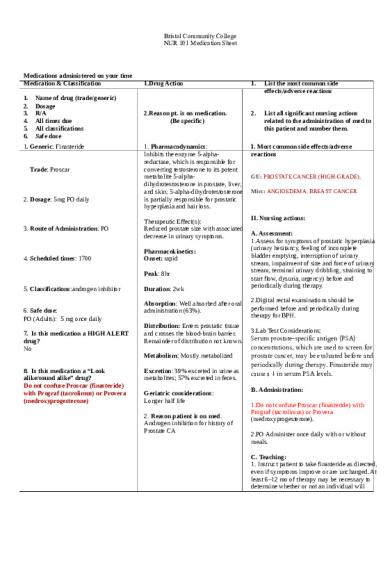Finasteride - drug sheet PDF

| Title | Finasteride - drug sheet |
|---|---|
| Author | Katherine Mentzer |
| Course | Fundamentals Of Nursing |
| Institution | LaGuardia Community College |
| Pages | 2 |
| File Size | 110.1 KB |
| File Type | |
| Total Downloads | 39 |
| Total Views | 134 |
Summary
drug sheet...
Description
Bristol Community College NUR 101 Medication Sheet
Medications administered on your time Medication & Classification 1. 2. 3. 4. 5. 6.
Name of drug (trade/generic) Dosage R/A All times due All classifications Safe dose
1. Generic: Finasteride
Trade: Proscar
2. Dosage: 5mg PO daily
3. Route of Administration: PO
4. Scheduled times: 1700
1.Drug Action
1.
List the most common side effects/adverse reactions
2.Reason pt. is on medication. (Be specific)
2.
List all significant nursing actions related to the administration of med to this patient and number them.
1. Pharmacodynamics: Inhibits the enzyme 5-alphareductase, which is responsible for converting testosterone to its potent metabolite 5-alphadihydrotestosterone in prostate, liver, and skin; 5-alpha-dihydrotestosterone is partially responsible for prostatic hyperplasia and hair loss.
I. Most common side effects/adverse reactions
Therapeutic Effect(s): Reduced prostate size with associated decrease in urinary symptoms. Pharmacokinetics: Onset: rapid Peak: 8hr
5. Classifications:androgen inhibitor 6. Safe dose: PO (Adults): 5 mg once daily 7. Is this medication a HIGH ALERT drug? No
Duration: 2wk Absorption: Well absorbed after oral administration (63%). Distribution: Enters prostatic tissue and crosses the blood-brain barrier. Remainder of distribution not known. Metabolism: Mostly metabolized
8. Is this medication a “Look alike/sound alike” drug? Do not confuse Proscar (finasteride) with Prograf (tacrolimus) or Provera (medroxyprogesterone)
Excretion: 39% excreted in urine as metabolites; 57% excreted in feces. Geriatric considerations: Longer half life 2. Reason patient is on med. Androgen inhibition for history of Prostate CA
GU: PROSTATE CANCER (HIGH-GRADE), Misc: ANGIOEDEMA, BREAST CANCER
II. Nursing actions: A. Assessment: 1.Assess for symptoms of prostatic hyperplasia (urinary hesitancy, feeling of incomplete bladder emptying, interruption of urinary stream, impairment of size and force of urinary stream, terminal urinary dribbling, straining to start flow, dysuria, urgency) before and periodically during therapy. 2.Digital rectal examinations should be performed before and periodically during therapy for BPH. 3.Lab Test Considerations: Serum prostate-specific antigen (PSA) concentrations, which are used to screen for prostate cancer, may be evaluated before and periodically during therapy. Finasteride may cause a ↓ in serum PSA levels. B. Administration: 1.Do not confuse Proscar (finasteride) with Prograf (tacrolimus) or Provera (medroxyprogesterone). 2.PO Administer once daily with or without meals. C. Teaching: 1. Instruct patient to take finasteride as directed, even if symptoms improve or are unchanged. At least 6–12 mo of therapy may be necessary to determine whether or not an individual will
Bristol Community College NUR 101 Medication Sheet
respond to finasteride. 2.Advise patient to read the Patient Package Insert prior to starting therapy and with each Rx refill in case of changes. 3.Inform patient that the volume of ejaculate may be decreased and erectile dysfunction and decreased libido may occur during therapy and after therapy is completed. 4. Advise patient to notify health care professional promptly if changes in breasts (lumps, pain, nipple discharge) occur. 5.Inform patient that there is an increased risk of high grade prostate cancer in men taking this drug. 6.Emphasize the importance of periodic followup exams to determine whether a clinical response has occurred.
(Vallerand, A. H. & Sanoski, C. A., 2020, pp. 576-577).
Vallerand, A., & Sanoski, C. (2020). Davis's drug guide for nurses (17th ed.). F.A. Davis Company....
Similar Free PDFs

Finasteride - drug sheet
- 2 Pages

Glucagon - drug sheet
- 3 Pages

Klonopin - drug sheet
- 3 Pages

Metoprolol - drug sheet
- 2 Pages

Docusate sodium - drug sheet
- 2 Pages

Common Drug Stems Cheat Sheet
- 2 Pages

Common Drug Stems Cheat Sheet
- 2 Pages

Med Card Finasteride
- 1 Pages

ATI medication finasteride
- 1 Pages

Drug Cards - Drug Card-start
- 16 Pages

Drug Cardwk 7 - drug card
- 6 Pages

Drug Normalisation
- 3 Pages

Drug properties
- 3 Pages
Popular Institutions
- Tinajero National High School - Annex
- Politeknik Caltex Riau
- Yokohama City University
- SGT University
- University of Al-Qadisiyah
- Divine Word College of Vigan
- Techniek College Rotterdam
- Universidade de Santiago
- Universiti Teknologi MARA Cawangan Johor Kampus Pasir Gudang
- Poltekkes Kemenkes Yogyakarta
- Baguio City National High School
- Colegio san marcos
- preparatoria uno
- Centro de Bachillerato Tecnológico Industrial y de Servicios No. 107
- Dalian Maritime University
- Quang Trung Secondary School
- Colegio Tecnológico en Informática
- Corporación Regional de Educación Superior
- Grupo CEDVA
- Dar Al Uloom University
- Centro de Estudios Preuniversitarios de la Universidad Nacional de Ingeniería
- 上智大学
- Aakash International School, Nuna Majara
- San Felipe Neri Catholic School
- Kang Chiao International School - New Taipei City
- Misamis Occidental National High School
- Institución Educativa Escuela Normal Juan Ladrilleros
- Kolehiyo ng Pantukan
- Batanes State College
- Instituto Continental
- Sekolah Menengah Kejuruan Kesehatan Kaltara (Tarakan)
- Colegio de La Inmaculada Concepcion - Cebu


